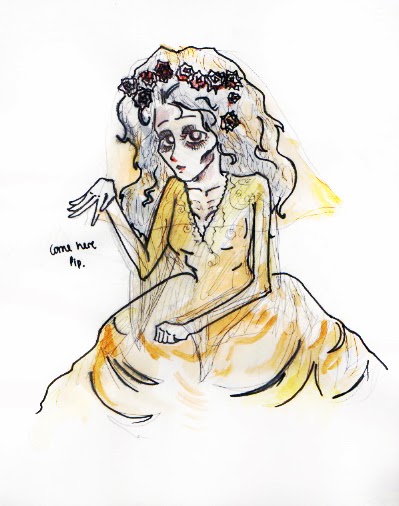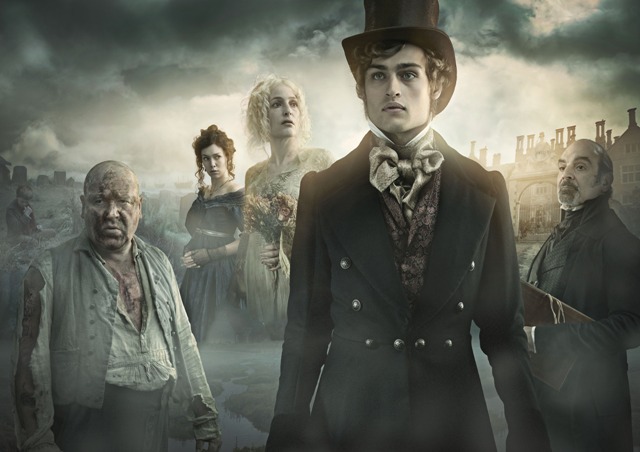Great Expectations was set in England during the early to mid 1800s. This period is known as the Victorian era, because of the reign of Queen Victoria - a time period in which great Britain was transformed by industrial, social and cultural developments. Great Britain was experiencing the industrial revolution.
To understand this project brief furthermore, I have researched the roles and appearance of Victorian women to strengthen my understanding of the characters: Miss Havisham and Estella.
 |
| Available from: www.fineartamerica.com Last accessed: 29 Jan 2014 |
During the reign of Queen Victoria, a women's place was at home. Unless you were well off, as a woman, you were in charge of all the household duties. Women were also seen as the possession of men. A wealthy widow or spinster (Miss Havisham) was a lucky exception, however, remaining single would attract social disapproval and pity.
Miss Havisham was a very wealthy woman, and she was not restricted by a man: she had plenty of freedom. In contrast, Estella gave her hand to the brutish nobleman Drummle, no different to becoming a slave, but she pushed to make both of their lives hell.
On the otherhand, women's clothing symbolised their constricted lives. Tight lacing into corsets and multiple layers of skirts impended a woman's freedom of movement. This challenges my perception of Miss Havisham, being single and wealthy; could she have thrown off the corset and presented herself in more flowing material like the Havisham in the Gillian Anderson version, or would she remain restricted and stiff like the Miss Havisham by Helena Bonham?
Historically, skirts were so wide that many women died engulfed in flames after the material caught fire from an open grate or candle. -Flashback to Miss Havisham's death, was it intentional or was it suicide?
Victorian women were not supposed to wear make-up, anything obvious on the cheeks and lips and you were a tart. However, they focused more on skin care and the less they did to their face, the more they did to their hair.
 |
| Image available from: http://gibsonglamor.blogspot.co.uk Last Accessed: 29th Jan 2014 |
Are you amused at the 'You are thirty? I have noticed that in many early advertisements, they like to point out flaws directly and insult the reader into buying products. Besides that, I have drawn attention to this particular add because of the key words, 'soft velvety whiteness'. Paleness was admired in the Victorian era, women who had a whiter complexion appeared more beautiful and those who were tanned were considered lower working class. Surprisingly, this idea is still relevant to eastern countries like China and Japan.
This idealism of paleness reflects my perception of Estella and Miss Havisham. Estella would be pale, a beautiful, youthful whiteness; which also reflects her cold lack of emotions. Whilst Miss Havisham can still be very beautiful, I see her as ghostly white, a white not full of youthfulness but a decaying white as she shrivels in her wedding dress.
 |
| Available from: www.victoriannonsense.com Last accessed: 29th Jan 2014 |
When it came to hair, it was their most prized possession. Women who could afford to style their hair to the latest fashions often had very damaged hair which gave off, from lots of heat styling, a burnt smell, which was then covered up by strong perfumes. You can see in some of the photos above that some of the hair has reduced to a very sheep-like texture. It was very fashionable for a woman to wear her hair in a smooth soft centre parting through to the 1870s. Curly hair was most popular, it was believed to indicate a sweeter, more gentle disposition. However, for women who lacked hair, hairpieces were widely available.
A woman's hair had an effect on how she was perceived. Curly hair was a sign of a softer nature and has an element of youth, whilst women who wore their hair in straighter styles could have been perceived as more reserved and even unrefined. Hair was also styled according to age, when a girl's hair was long enough to be styled up, it was seen as a blossoming stage for young women.
Although hair was often seen as a beautiful aspect, it can also be seen as a dangerous tool. Imagine what Rapunzul could have done with her hair if you got on the bad side of her.
 |
| Available from: www.yearningforwonderland.com Last accessed: 29th Jan 2014 |
Above is a famous painting 'La Belle Dame Sans Merci' (The beautiful lady without mercy.
'I met a lady in the meads,
Full beautiful—a faery’s child,Her hair was long, her foot was light,
And her eyes were wild'
-John Keats
We can see that from the image and the title of the piece that beautiful hair can be a deadly weapon. Hair can be compared to a spiders web and a poisonous snake; both very sinister images. Estella is beautiful, her hair must also be beautiful, enough to capture her victim and destroy it. I want to develop this idea when I design my image for Estella.




















